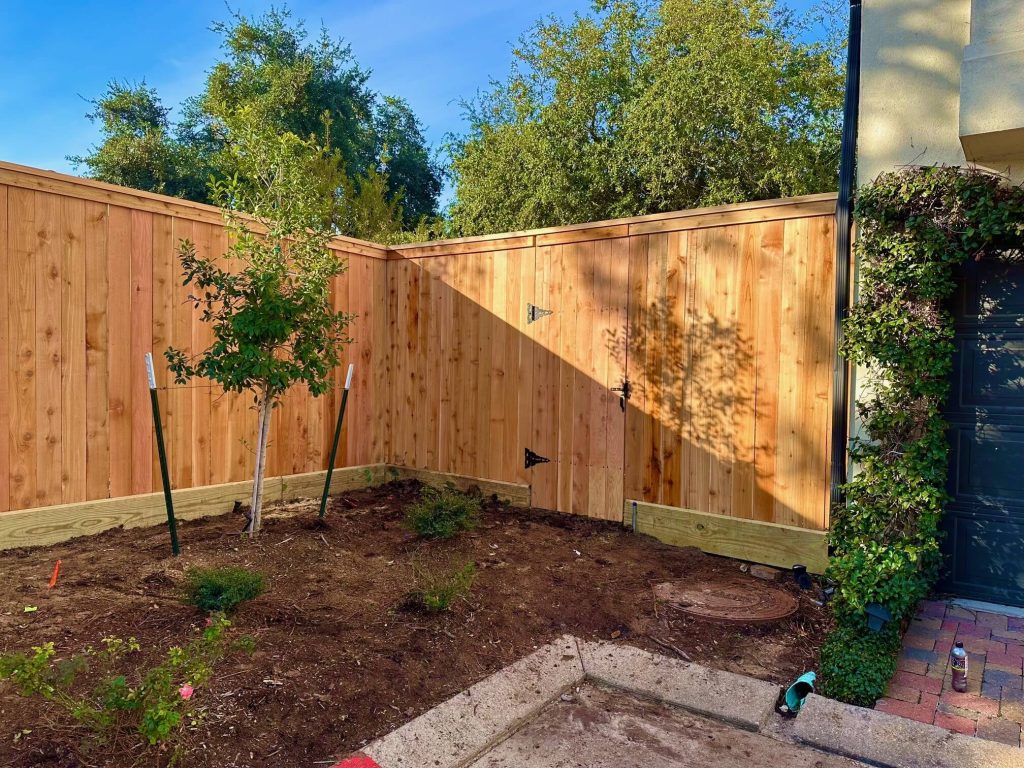Beautiful Wood Fences for Your Backyard: Styles, Privacy and Installation
Installing wood fences offers numerous benefits, including privacy, aesthetic appeal, and natural durability. Wood fence installation can enhance the security and curb appeal of your property while providing a warm, inviting atmosphere.

Types of Wood Fences
When it comes to choosing the right type of wood for your fence, factors like durability, maintenance, and aesthetics are essential. Let’s explore some common options:
Pine
Pine is a popular choice in residential settings due to its affordability and availability. It’s often pressure-treated to resist rot, decay, and pests, making it a practical choice for those looking to balance budget with durability. However, pine may require regular maintenance to uphold its structural integrity and appearance over time.
Cedar
Cedarwood is known for its natural resistance against decay, insects, and severe weather conditions. Its robustness and ability to maintain quality over time make it a favored choice for outdoor fencing. In addition to these benefits, cedar also emits a pleasant aroma that can add a delightful touch to your backyard space.
Redwood
Redwood is renowned for its rich color, durability, and upscale aesthetic appeal. Its natural resistance to decay and insects, combined with its luxurious appearance, makes it an attractive but higher-end option for homeowners seeking long-term value from their wood fences.
Spruce
Spruce is a lightweight and more affordable alternative suitable for decorative fencing in residential settings. While it offers initial cost savings, it requires consistent upkeep and maintenance to uphold its structural integrity and visual appeal.
These are just a few of the wood fences options available for building a sturdy and visually appealing fence in your backyard. Each type has unique characteristics that cater to different needs and preferences. By understanding the benefits of each type, you can make an informed decision that aligns with your specific requirements while complementing the overall aesthetic of your outdoor space.
Understanding the unique properties of each type of wood can help you assess which one best suits your individual needs. For instance, if you prioritize cost-effectiveness combined with durability, pine might be the ideal option; however, if you’re keen on long-term aesthetics along with low maintenance demands, redwood or cedar could be better suited.
The key lies in selecting the right wood that enhances the visual appeal of your backyard while aligning with your budget and lifestyle needs.
With ample information about each type of wood fence at your disposal, you’ll be able to make an educated decision that ensures both functionality and aesthetic appeal for your outdoor space. Our goal is to assist you in making a well-informed choice that enhances the ambiance of your property while meeting your practical requirements.
Popular Styles and Designs
When it comes to adding personality and functionality to your backyard, there are several popular styles and designs of wood fences to choose from. Each style offers something unique, whether it’s charm, privacy, or a touch of elegance. Let’s explore some of the most sought-after designs that are not only visually appealing but also cater to different functional needs.
Picket Fences
Picket fences have been a staple in American yards for centuries, evoking feelings of warmth, tradition, and homeliness. With their iconic pointed slats arranged in a neat row, picket fences create a boundary without blocking off your property entirely. They are ideal for demarcating front yards and adding curb appeal. Moreover, they come in various decorative shapes, allowing you to add a personal touch to your property.
Picket wood fences are not just about defining spaces; they also serve as an aesthetic expression by complementing the architectural style of your home. Looking to achieve a distinctly classic and charming look for your outdoor space while maintaining a sense of openness? Picket fences are an excellent option.
Privacy Fences
If seclusion is what you desire in your backyard retreat, then privacy fences are the way to go. These tall, solid structures provide maximum isolation from the outside world. Whether you’re hosting gatherings on warm summer evenings or simply unwinding outdoors, privacy fences offer the peace and tranquility you need. They create an intimate oasis where you can relax without worrying about prying eyes.
Privacy fences also act as a sound barrier, helping to minimize noise from nearby roads or neighbors. By creating a secluded outdoor space shielded from surrounding disturbances, privacy fences allow you to relish in the serenity of your backyard environment without interruptions.
Lattice Fences
Looking for a balance between openness and privacy? Lattice fences offer the perfect blend of both. These unique fences feature crisscrossed wooden slats that provide partial privacy while allowing glimpses of the surrounding landscape. They serve as an attractive backdrop for climbing plants and vines, adding a touch of natural beauty to your yard.
In addition to their decorative function, lattice fences enhance airflow through your property, promoting better ventilation in your outdoor space while providing just enough seclusion.
Split Rail Fences
If you’re seeking a rustic and open feel for your backyard, split rail fences fit the bill perfectly. Commonly seen in large gardens and rural settings, these three-rail constructions create a sense of expansiveness without completely closing off your property.
Split rail fences are versatile and can be used decoratively to border expansive landscapes without obstructing views of surrounding natural beauty. Their simplicity and understated charm make them ideal for creating boundaries that seamlessly integrate with the surrounding environment.
Whether you seek traditional charm with picket fences or desire maximum seclusion with privacy fences, there’s certainly a wood fence style that suits your unique needs and preferences. Each design has its own distinct features that cater to both functional and aesthetic aspects in transforming your backyard into an inviting outdoor sanctuary.
As we step closer into exploring how wood gates perfectly complement these fence styles in enhancing the overall aesthetics and functionality of outdoor spaces.
Installing and Constructing Wooden Gates for Wood Fences
When adding a gate to wood fences, there are crucial steps to ensure it is both secure and aesthetically pleasing. It’s an opportunity to extend the beauty and functionality of your wood fence.
First and foremost, choosing the right gate material is crucial. The gate should complement the overall style of your wood fence so that it looks like a seamless addition, not an afterthought. Whether you have a picket, split rail, or privacy fence, selecting a matching wood for your gate will ensure that it blends in well.
Matching the type of wood and stain, or paint, will give a cohesive look to your fence and gate ensemble. While it might seem like a small detail, a mismatched gate can stand out and detract from the visual appeal of your overall fence.
For instance, if your fence is crafted from cedar with a stained finish, choose a cedar gate with a matching stain to maintain uniformity. This creates an elegant look that adds extra appeal to your outdoor space.
Step I – Choose the Right Gate Material
The next step is measuring and marking where your gate will be installed. Proper measurements are crucial for ensuring that the gate fits between the posts without any gaps or fitting too tightly. It’s important to take accurate measurements to avoid installation issues down the line.
Think of it as creating a frame for a piece of art. You wouldn’t want the frame to be too big or too small – it needs to fit just right. By measuring carefully and marking the placement of the gate, you set yourself up for success in installation.
If your fence posts are eight feet apart, then your gate shouldn’t be much smaller than seven feet wide to allow for proper clearance. Taking these measurements will help prevent any issues when installing the gate.
Step II – Measure and Mark
Moving on to step three: installing sturdy hinges. Once you’ve chosen the right material and measured for placement, using heavy-duty, weather-resistant hinges is vital for longevity of wood fences. The hinges bear the weight of the gate and constant movement when opening and closing.
Just as we rely on sturdy foundations for our homes, installing sturdy hinges ensures that our gates are durable. It’s all about securing our investments and keeping things running smoothly.
Consider using stainless steel or galvanized steel hinges that are designed to withstand outdoor elements such as rain, wind, and temperature variations without corroding or warping.
Step III – Install Sturdy Hinges
Transitioning from constructing wooden gates to understanding their benefits provides a comprehensive view of why they’re an excellent choice for enhancing backyard spaces **
Advantages of Choosing Wood Fences
When considering the perfect material for your backyard fence, wood offers a wealth of benefits that make it an attractive option for homeowners. One of the most appealing aspects of wood fences is their versatility in accommodating various aesthetic preferences. Whether you prefer a classic, stained look or a vibrant pop of color with paint, wood can be customized to fit your personal style seamlessly.
This flexibility extends beyond just color choices. The natural appearance of wood allows it to blend seamlessly with any landscape or architectural style, adding warmth, character, and timeless appeal to your property, thus enhancing its visual charm.
Another significant benefit of wood fencing is its environmental friendliness. As a renewable resource, wood is a sustainable choice compared to other materials. Choosing wood as your fencing material not only adds natural beauty to your surroundings but also helps reduce your environmental impact.
Moreover, when it comes to maintenance and repairs, wood trumps many other fencing materials. If a wooden fence sustains damage over time, repairing it is typically simpler and more cost-effective than with other materials like vinyl or metal. This makes it an appealing choice for homeowners seeking long-term durability and ease of maintenance.
For instance, if a section of your wooden fence sustains damage from severe weather or general wear and tear, in most cases, you can address the issue by replacing individual boards or posts rather than having to overhaul the entire structure – a convenience that many homeowners appreciate.
Wood fences offer a level of craftsmanship and character that cannot be replicated by other materials. They carry a sense of tradition and timelessness that resonates with many homeowners seeking to create an inviting and picturesque atmosphere in their outdoor spaces.
Enhancing Backyard Privacy
Creating a private outdoor sanctuary is a crucial consideration for many homeowners. A wooden fence offers a classic, effective solution to this concern. The key to achieving optimal backyard privacy lies in the design and installation of your wooden fence.
Height Matters: One effective way to increase privacy is by selecting a tall fence. For enhanced seclusion, consider installing a fence that is at least 6 to 8 feet high. This will obstruct the view into your yard, providing immediate privacy and reducing noise from the outside world.
Board-on-Board Design: Opting for a board-on-board design for your wood fence can be highly effective. With this design, the boards overlap each other, ensuring complete privacy by eliminating gaps. This construction method not only adds to your backyard privacy but also gives your fence a seamless, attractive appearance.
Plant Integration: Another effective strategy is to integrate shrubbery and vines along the fence line. By incorporating greenery, you create a natural barrier that enhances seclusion and aesthetic appeal. The lush foliage not only adds visual interest and beauty but also contributes to a sense of peaceful seclusion, transforming your backyard into a serene oasis.
Cost-Effective Installation Tips
When considering the installation of wood fences, various methods can help save money on the overall installation process. Here are some cost-effective tips to consider:
DIY Installation
One of the most effective ways to save on labor costs is to consider installing the fence yourself. Although this may involve some initial research and learning, taking the DIY approach can potentially save a significant amount of money compared to hiring professional installers. It’s important to ensure that you have the necessary tools and skills for the job before diving in.
Aside from the potential cost savings, embarking on a DIY fence installation project can be a very rewarding experience.
Purchase in Bulk
Buying materials in larger quantities can often result in a reduced price per unit. Whether it’s the wood panels, posts, or hardware, purchasing materials in bulk may offer substantial savings on the overall cost of the project. It’s important to carefully calculate the amount of materials needed to avoid over-purchasing and unnecessary expenses.
Moreover, buying in bulk provides an advantage beyond just cost savings – having excess materials on hand can be beneficial for any future repairs or maintenance needs.
Seek Local Discounts
Many local suppliers may offer discounts during off-season periods or when they have excess stock. Keeping an eye out for sales or promotions can lead to significant savings on fence materials. Additionally, establishing positive relationships with local suppliers may open up opportunities for future discounts or special offers.
For instance, during certain times of the year, such as winter months when demand for fencing materials may be lower, suppliers might offer discounted prices to reduce excess inventory and make space for new shipments.
Reuse and Recycle
Using reclaimed wood is not only an eco-friendly choice but it can also significantly reduce costs while adding a unique rustic charm to your fence. Reclaimed wood can often be sourced at lower prices than new materials while providing an authentic weathered look that complements the natural aesthetic of a backyard.
By exploring these cost-effective installation tips, it’s clear that making informed choices about the installation process can lead to substantial savings while still achieving a visually appealing and structurally sound wood fence for your backyard.
Maintenance Tips for Longevity
Taking care of your wood fence is crucial for extending its lifespan and maintaining its appearance. Our wood fences are an investment in the charm and security of our homes, so it’s essential to keep them well-protected from the elements and potential damage.
Regular Sealing and Staining
Applying sealant or stain to your wood fence every couple of years creates a protective barrier against moisture and harmful UV rays, preventing warping, cracking, and premature aging. The sealant preserves the wood’s natural beauty while guarding against weather-related damage.
Once you apply the sealant or stain, it’s important to inspect the fence periodically to ensure the coating is still effective. Over time, harsh weather conditions can degrade the protective layer, and reapplying it when necessary will help maintain the fence’s integrity.
Inspect and Repair
Regular inspections of your wooden fence are crucial for catching signs of trouble early. Check for any rot, termite damage, loose boards, or other issues that could compromise the strength and stability of the fence. Promptly addressing these problems can prevent small issues from escalating into major repairs down the line.
Upon inspection, if you notice any damaged or rotting sections, taking action as soon as possible will mitigate further deterioration. Addressing problems promptly ensures that you’ll spend less time and money on repairs in the long run.
Clean Annually
Routine cleaning is another secret to keeping your wood fence in tip-top condition. Washing the fence with a mild detergent and water removes accumulated dirt, mold, and mildew. This cleaning process not only maintains its attractive appearance but also prevents decay caused by organic growth.
Trim Nearby Vegetation
Maintaining your garden or yard involves more than just aesthetic upkeep; it’s an integral part of preserving your wooden fence. Overgrown plants and trees can hold excess moisture against the fence, promoting mold growth and wood decay. By trimming back vegetation from your fence line, you’re preventing potential moisture issues and reducing hiding spots for pests.
Final Thoughts
Caring for a wooden fence may seem like hard work, but it’s essential to protect this valuable asset over time. Regular sealing, inspections, cleanings, and landscaping upkeep go a long way in ensuring that your wood fence remains sturdy, beautiful, and long-lasting.
The care given to a wooden fence provides numerous long-term benefits but how does wood compare to other fencing materials? Let’s dive into comparing these options in “Benefits Over Other Materials.
Benefits Over Other Materials
When it comes to fencing materials, wood boasts its own unique set of advantages. Let’s explore these benefits in detail to understand why it’s a favored choice for many homeowners.
Aesthetic Flexibility: Wood fencing offers remarkable aesthetic flexibility. It can be easily tailored to fit any yard style or homeowner preference. Whether you prefer a classic picket fence or a more modern design, wood can be crafted to suit your vision.
Consider the warm, natural look of a wooden fence which can complement the organic elements in your backyard. The various options for stain or paint colors allow you to match your fence to your home’s exterior or landscaping. This level of customization adds an extra touch of personalization to your property, setting it apart from other materials.
Whether you’re going for a cozy cottage feel or a sleek modern look, wood offers adaptability and character that many other materials simply cannot match.
Repair Simplicity: If there’s ever damage or wear on your wood fence, repairing it is usually straightforward, often requiring just the replacement of individual boards.
Cost-Effective: In fact, speaking of repairs, wood fences are more cost-effective overall. Initial costs for wood fencing are often lower than materials like wrought iron or vinyl, especially considering the ease of maintenance and repair.
Sure, initially the upfront costs might seem higher for wrought iron or vinyl installations, but when you weigh in all the additional expenses and potential repairs down the line, wood fencing emerges as a cost-effective and practical choice for many homeowners.
Eco-Friendly: Wood is not only aesthetically pleasing and cost-effective but also eco-friendly. Being biodegradable and sourced sustainably makes it a greener choice compared to vinyl or metal.
Consider the environmental impact—wooden fences are less taxing on natural resources when compared to their non-biodegradable counterparts. If sustainability is important to you, you may find comfort in knowing that wood fences have less long-term impact on the environment.
Conclusion
Whether it’s about aesthetics, cost-effectiveness, or environmental concerns, wood emerges as a popular choice for various reasons. Its authentic appeal and practicality make it a versatile option for homeowners looking to invest in a durable and visually appealing boundary for their property.
For high-quality wood fencing solutions, contact Texas Fence at https://texasfence.com/.








